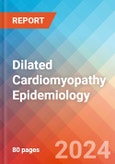Dilated Cardiomyopathy Understanding
Cardiomyopathy is a general term that refers to the disorders of the cardiac muscle that cause mechanical or electrical dysfunction that results in dilated, hypertrophic, or restrictive pathophysiology. According to the National Organization for Rare Disorders (NORD), dilated cardiomyopathy is a progressive heart condition characterized by the enlargement of the heart's left ventricle, leading to decreased pumping function and heart failure. By definition, patients have systolic dysfunction and may or may not have overt symptoms of heart failure. It is the most common type of cardiomyopathy and typically affects those aged 20-60. Dilated cardiomyopathy progression can be classified as either primary or secondary dilated cardiomyopathy.Symptoms of dilated cardiomyopathy can range from asymptomatic to severe heart failure, including dyspnea on exertion, fatigue, palpitations, dyspnea, peripheral edema, arrhythmias (ventricular tachycardia, atrial fibrillation), and others.
While the cause of dilated cardiomyopathy is often unknown (idiopathic), some cases are acquired, including infections (viral myocarditis), toxins (alcohol abuse, chemotherapeutic agents), autoimmune diseases, and nutritional deficiencies, whereas roughly half are inherited or familial. These complex interactions between genetic predisposition, environmental factors, and molecular mechanisms can contribute to mitochondrial dysfunction, myocardial damage and remodeling, and hemodynamic consequences.
Dilated Cardiomyopathy Diagnosis
The diagnosis of dilated cardiomyopathy involves a systematic approach aimed at identifying structural and functional abnormalities in the heart and ruling out other potential causes of cardiac dysfunction. Dilated cardiomyopathy is diagnosed through a comprehensive evaluation that includes a combination of clinical assessment, imaging studies, laboratory tests, and genetic testing...
Dilated Cardiomyopathy Epidemiology Perspective
The disease epidemiology covered in the report provides historical as well as forecasted epidemiology segmented by total prevalent cases of dilated cardiomyopathy, total diagnosed prevalent cases of dilated cardiomyopathy, gender-specific cases of dilated cardiomyopathy, familial and non-familial cases of dilated cardiomyopathy, in the 7MM covering the United States, EU4 (Germany, France, Italy, and Spain) and the United Kingdom, and Japan from 2020 to 2034.Dilated Cardiomyopathy Detailed Epidemiology Segmentation
- According to estimates, the total prevalent cases of dilated cardiomyopathy in the 7MM were approximately 3,045,174 in 2023, which is expected to increase by 2034.
- Among the 7MM, the US accounted for approximately 51.8%, EU4 and the UK for nearly 37.6%, and Japan for around 10.6% of the total diagnosed prevalent cases of dilated cardiomyopathy in 2023; these cases are expected to change by 2034.
- Among EU4 and the UK, in 2023 Germany accounted the highest diagnosed prevalent population of dilated cardiomyopathy, with nearly 103,096 cases, followed by France with approximately 83,529 cases. On the other hand, Spain had the lowest diagnosed prevalent population with nearly 57,806 cases in 2023. These cases are expected to change during the study period.
- The diagnosed prevalent cases of dilated cardiomyopathy in the 7MM varied according to gender, with prevalent cases higher in males than in females. Assessments as per the analysts show that the overall prevalence of dilated cardiomyopathy in males was approximately 732,232 cases, while it was 338,279 cases in females in 2023, and these cases are projected to rise in the coming years.
- The gender-specific cases of dilated cardiomyopathy in the US were nearly 351,075 for males and 203,312 for females in 2023 and are expected to increase within the forecast period.
- Among the 7MM, Japan accounted for the second highest diagnosed prevalent cases of dilated cardiomyopathy, i.e. approximately 113,585 cases in 2023. Of these nearly 34,076 cases accounted for genetic or familial cases of dilated cardiomyopathy, while there were nearly 79,510 cases for non-familial/other dilated cardiomyopathy in 2023.
Scope of the Report
- The report covers a descriptive overview of dilated cardiomyopathy, explaining its symptoms, pathophysiology, and various diagnostic approaches.
- The report provides insight into the 7MM historical and forecasted patient pool covering the United States, EU4 (Germany, France, Italy, and Spain) the United Kingdom, and Japan.
- The report assesses the disease risk and burden of dilated cardiomyopathy.
- The report helps recognize the growth opportunities in the 7MM concerning the patient population.
- The report provides the segmentation of the disease epidemiology for the 7MM, by total prevalent cases of dilated cardiomyopathy, total diagnosed prevalent cases of dilated cardiomyopathy, gender-specific cases of dilated cardiomyopathy, and familial and non-familial cases of dilated cardiomyopathy.
Report Highlights
- 11 years forecast of dilated cardiomyopathy
- The 7MM Coverage
- Total prevalent cases of dilated cardiomyopathy
- Total diagnosed prevalent cases of dilated cardiomyopathy
- Gender-specific cases of dilated cardiomyopathy
- Familial and non-familial cases of dilated cardiomyopathy
Key Questions Answered
- What are the disease risks and burdens of dilated cardiomyopathy?
- What is the historical dilated cardiomyopathy patient pool in the United States, EU4 (Germany, France, Italy, and Spain) the United Kingdom, and Japan?
- What would be the forecasted patient pool of dilated cardiomyopathy at the 7MM level?
- What growth opportunities will be across the 7MM concerning the patient population with dilated cardiomyopathy?
- Which country would have the highest diagnosed prevalent population of dilated cardiomyopathy among the countries mentioned above during the forecast period (2024-2034)?
- At what CAGR is the population expected to grow across the 7MM forecast period (2024-2034)?
Reasons to Buy
The dilated cardiomyopathy report will allow the user to:
- Develop business strategies by understanding the trends shaping and driving the 7MM dilated cardiomyopathy epidemiology forecast.
- The dilated cardiomyopathy epidemiology report and model were written and developed by Masters and PhD level epidemiologists.
- The dilated cardiomyopathy epidemiology Model is easy to navigate, interactive with a dashboard, and epidemiology based on transparent and consistent methodologies. Moreover, the model supports the data presented in the report and showcases disease trends over the 11-year forecast period using reputable sources.
Key Assessments
- Patient Segmentation
- Disease Risk and Burden
- Risk of Disease by Segmentation
- Factors Driving Growth in a Specific Patient Population
Geographies Covered
- The United States
- EU4 (Germany, France, Italy, and Spain) and the United Kingdom
- Japan








